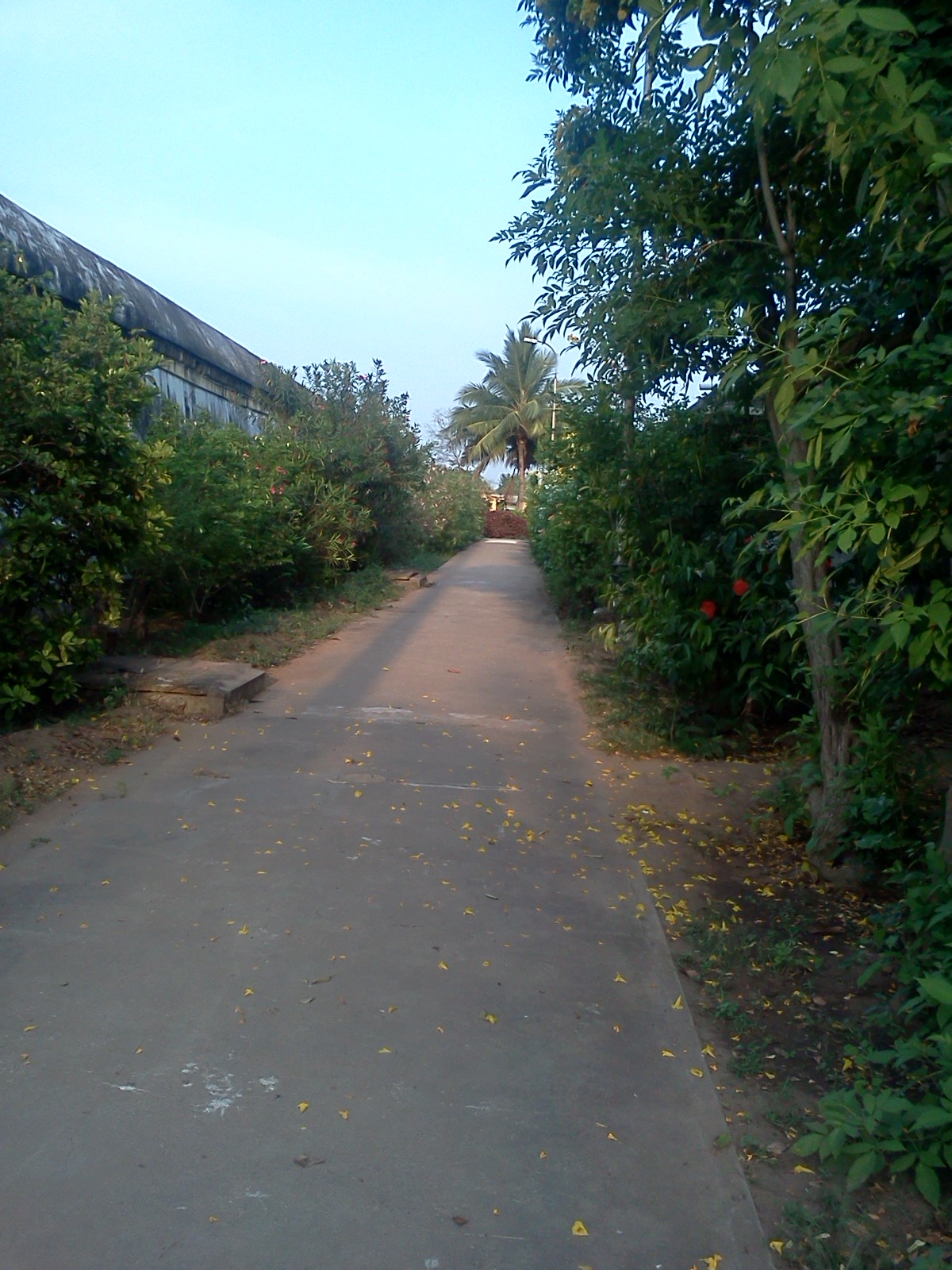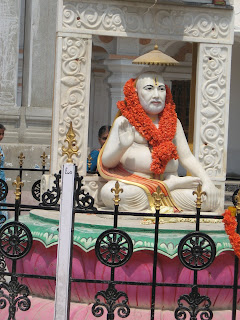My Spiritual Travelogue
Arulmigu Sri Ramanathaswami Temple - Rameshwaram
We planned our visit to Rameshwaram keeping in mind to perform our pithru rites during Mahalaya Paksha period (Sept. 2012) at Rameshwaram, combining with our longer wish to fullfil - to have darshan of Shri Ramanatha swamy at Rameshwaram.
From Chennai, we started off by train to Madurai where we landed at about 8.00 p.m. Due to some track work, the journey was terminated at Koodal Nagar instead of Madurai Junction. On alighting from the train, we were greeted by heavy drizzling and was wading through the same to reach Madurai junction railway station where Rameshwaram passenger train leaving at midnight. Added to the our owe, Madurai junction railway station was in pitch dark due to power failure. Somehow, we managed to get into our train which left after a delay of 40 mts from its scheduled departure. The journey was a little bit husky. We landed at Rameshwaram station on the following morning at about 4.30 a.m.
The early morning cool sea breeze kindled our spirits from the sleepy mood and set sail our enthu to the day's active schedule. We checked-in to a lodge, dumped our baggages and taking the advise of the inn-keeper, we proceeded to Shri Ramanathaswamy temple to have 'spadiga linga pooja' darshan. This darshan in the early morning before sunrise is said to be a gifted opportunity for the pilgrims. Chanting of the powerful mantra 'Om NamaShivaya' and of having the 'spadiga linga' darshan in that early morning spiritually took us to a heavenly abode. There is a belief that the 'spadiga lingam' was given by Sankaracharya to this temple.
Next, we engaged a prohit and jeeps for visiting Dhanushkodi to perform our Theertha srartham or Hiranya srartham. The prohit had lined up all paraphernelia for the pooja and in two jeeps lead us to Dhanuskodi where we have to perform our rites at the confluence of Mahodadhi (Bay of Bengal) and Ratnakara (Indian Ocean).
Dhannushkodi is a town in the southern tip of south India. There is no proper road to Dhanushkodi. The stretch is through beach sand. No ordinary vehicle can travel in this sand dunes beach. There are lot of special small trucks available to travel to Dhanushkodi.
Mini tucks & Jeeps in the sand dunes
It is a journey, unimaginable to many, even for us till that moment, to be at the very southern end (tip) of India, but a realistic one for us. Emotionally, we were all speechless on seeing the vast roaring sea around our visinity, engulfed with the golden sun rays from the eastern horizan, twinkling waves through the golden rays. Oh, what a marvellous sight gifted by nature. With rapt attention, we stood motionless, enjoying the nature's beauty. But, for a sudden thud by our prohit, we would not have been back to realism. He was preparing for our doing the sankalpam and prayers on the sands of Dhanushkodi sea shore. He drew bows and arrows for each one of our families on the sand for performing our theertha srartham. He arranged everything so professionally and we did the rituals as per his command. Then, we were asked to take 30 snan dips in the sea. After this, we all straight away proceeded to Sri Ramanatha Swamy temple without changing the wet cloth.
Ramanathaswamy temple is the most important temple at Rameswaram. The temple is so constructed inside a compound wall of more than one kilometre, houses four marvelous corridors which have been beautifully carved or sculptured. It is said that the holy water of the divine water tanks inside the temple compound have tremendous powers to the pilgrims / visitors. The ponds inside the temple corridor have their own significance in belief and faith. temple corridor one can visit here is the longest in India.
The Legend related to the temple goes like this - on the advice of Rishis, Lord Rama along with Sita and Lakshmana, installed and worshipped the Sivalinga here to expiate the sin of Brahmahatya - killing of a Brahmin – Ravana while returning to Ayodhya. Rama wanted to do the Sivalinga installation at an auspicious time. He sent Hanuman to Mount Kailas to get a Sivalinga. Since Hanuman could not return with the Sivalinga in time before the auspicious time goes, Sita herself made a Lingam (Ramalingam) out of sand. The rituals were performed and after that Hanuman returned with a Linga from Mount Kailas.

The temple ponds inside the temple corridor have their own significance in faith. The concept is that just before purifying the soul inside the temple, one can purify the body in these “theerthams” or holy ponds. There are almost 36 Theerthams here in Rameshwaram, out of which 22 are in the temple. The water of these Theerthams are said to be therapeutic. A bath in these is regarded significant. The name of 22 Theerthams are -
Sethumadava Theertham,
Gayathri Theertham,
Saraswathy Theertham,
Maha lakshmi Theertham,
Savithri Theertham,
Gandhamadava Theertham,
Gavaksha Theertham,
Yamuna Theertham,
Gaya Theertham,
Siva Theertham,
Satyamrita Theertham,
Sarva Theertham,
Kodi Theertham,
Gavaya Theertham,
Nala Theertham,
Neela Theertham,
Sanku Theertham,
Chakra Theertham,
Brahmahatta vimochana Theertham,
Soorya Theertham,
Chandra Theertham,
Ganga Theertham
Gayathri Theertham,
Saraswathy Theertham,
Maha lakshmi Theertham,
Savithri Theertham,
Gandhamadava Theertham,
Gavaksha Theertham,
Yamuna Theertham,
Gaya Theertham,
Siva Theertham,
Satyamrita Theertham,
Sarva Theertham,
Kodi Theertham,
Gavaya Theertham,
Nala Theertham,
Neela Theertham,
Sanku Theertham,
Chakra Theertham,
Brahmahatta vimochana Theertham,
Soorya Theertham,
Chandra Theertham,
Ganga Theertham
After taking bath in all the 22 theerthams inside the temple, we went back to our prohit's place for performing our Mahalaya Paksha Tarpan which he arranged. After performing the Tarpan, we had darshan of Sri Ramanatha Swamy and his consort goddess Sri Parvathavarthini. The prohit also made arrangements for our lunch. After having a sumptuous lunch, we were getting ourselves ready for our return journey by evening. We reached Rameshwaram railway station and our return train was waiting at the platform.
We all wanted to have look on the Pamban Bridge which connects Rameshwaram on Pamban Island to mainland India. We could not have a look on the Pamban bridge in the night when we were ravelling to Rameshwaram as it was mid-night and pitch dark everywhere. So, we made it point to have good look on the Pamban Bridge on our return from Rameshwaram.
During the British Raj period, in late 1870, when East India Company was expanding its trade, a need arose for a rail link between Danushkodi and Colombo. Under the Indo-Ceylon Project, two proposals - i) rail bridge from Mandapam to Pamban and ii) from Danushkodi to Thalaimannar were sent to the British Parliament. The Mandapam - Danushkodi rail link project got approved by the British Parliament at a cost Rs. 70 Lakhs. South Indian Railway commenced the bridge construction in 1902. Work was smooth till constructing 112th pier from Mandapam side. At this stage, it was decided to allow ferry service as well. A German Engineer Scherzer designed and built the famous 65.23 metre long rolling type lift span which opens up to pave way for the vessels to pass through. After the erection of rolling lift centre span in 1913, the bridge was thrown open to traffic in Feb. 24, 1914 and recently, the bridge has completed its centenary year. The bridge with stood nature's fury in December 1964. The then President A.P.J. Abdul Kalam, who hailed from Rameswaram island suggested for gauge conversion of the rail track and the same was completed in 2007. The bridge was further strengthened in 2009 for movement of goods traffic. Recently, it suffered a jolt, when a barge which was drifting due to its anchor failure, crashed into the bridge, damaging the 121st pier. The same was rectified within a weeks' time and the train service was restored.
The Pamban Bridge is a cantilever bridge on the Palk Strait connects Rameshwaram on Pamban Island to mainland. There is a road bridge passes through adjacent to the cantilever railway bridge. It was India's first sea bridge. It is the second longest sea bridge in India (after Bandra-Worli Sea Link) at a length of about 2.3 KM. The rail bridge is a conventional bridge resting on concrete piers, but has a double leaf bascule section midway which can be raised to let ships and barges pass through. It is a magnificient sight for the eyes to view the cantilever railway bridge and the road bridge side by side in the mid sea in that evening sunset light.
With these sweet memories we returned to our base the next day morning and got mixed up with our daily chores. In that way, we were all very much gracefully blessed by the divine powers of Sri Ramanatha Swami of Rameshwaram in making our spiritual pilgrimage a very successful one both in spirits and health and kindled our enthusiasm for more and more such spiritual yatras.
வணக்கம்












































































